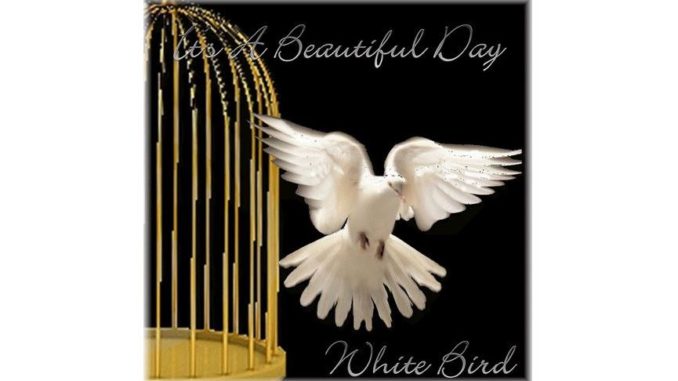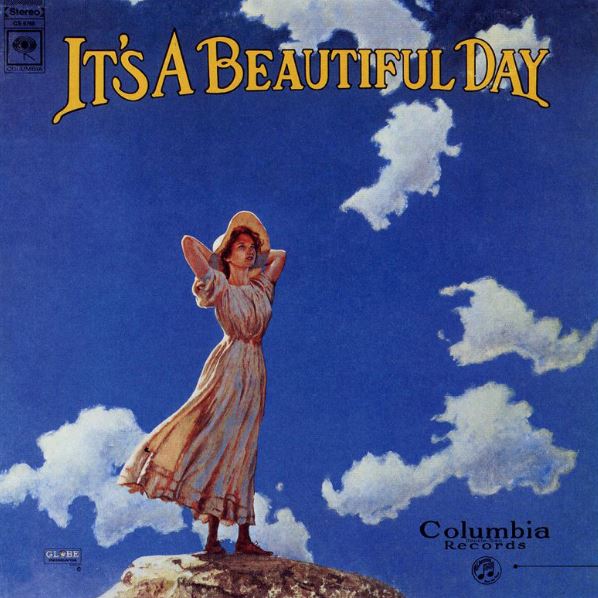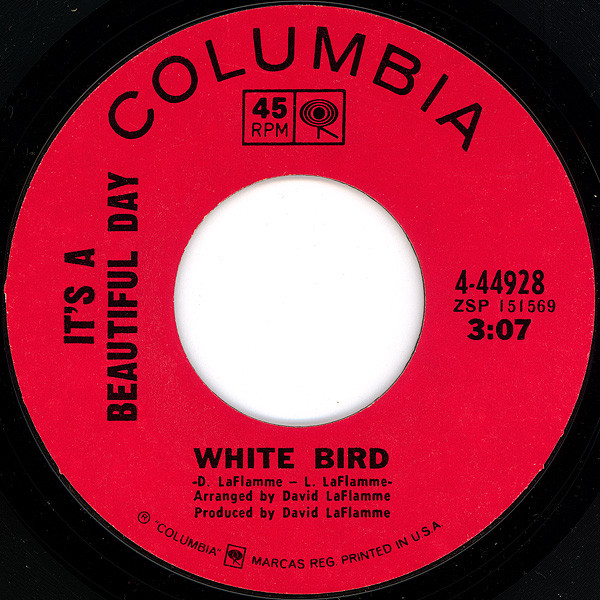
In the 1960s, there was a time when San Francisco was the centre of the universe. During the fabled Summer of Love in 1967 as many as 100,000 people, mostly young people sporting hippie fashions and behaviour, converged in San Francisco’s neighbourhood of Haight-Ashbury.
A lot of them also came to the area for the Monterey Pop Festival, which was a major cultural happening. It was the first mainstream music festival for “pop” music, sporting some of the biggest bands in the world at the time. Its theme song, sung by Scott McKenzie, was a worldwide hit, and told us to wear flowers in our hair if we were going there. San Francisco was the epicentre of the hippie culture, and the world was paying attention to the new culture, fashions, and lifestyle that was emerging from the area.
Music was a huge part of the scene with many bands popping up. One of those bands were It’s A Beautiful Day. They were one of the notable San Francisco bands to emerge from the Summer of Love era, but never quite managed to capitalise on the media interest before it had moved on. They were certainly not without success, and for a short time they burned brightly, but management issues and bad luck at key moments in their career worked against them. They remain in the shadow of their contemporaries Grateful Dead, Jefferson Airplane, and Santana, with whom they had connections.
It’s A Beautiful Day formed in 1967 in San Francisco. Their most prominent members were vocalist Pattie Santos along with violinist/vocalist David LaFlamme and his wife, Linda LaFlamme, on keyboards. The band played a unique brand of slightly psychedelic rock mixed with folk, prog, classical, and world music.
Their original manager was the notorious Matthew Katz, who had previously worked with Jefferson Airplane and Moby Grape. The members of IABD were unaware that as they signed with Katz, the other bands were trying to end their business relationship with him. Katz is especially remembered for his long and bitter legal battles with Moby Grape. He withheld funds and did not allow the band to use their name, but the band prevailed in court and Katz had to give up the name and pay back stolen royalties.
RELATED ARTICLE: The story behind the song «Hey Grandma» by Moby Grape
During 1967 and early 1968, Katz prevented IABD from performing in San Francisco, telling them they were not ready. Instead, he booked their first public appearances at a club in Seattle, convincing them that it would be a great opportunity to hone their craft. He may have neglected to tell the band that he was the owner of the club. It had been known as the Encore Ballroom, but Katz renamed the club San Francisco Sound in time for IABD’s stint there to cash in on the latest fad. IABD would be the house band of that club during December 1967.
The group rented the attic of a Victorian mansion during their stay, located across the street from Volunteer Park. It would later come to light that the mansion also happened to be owned by Katz. It was a miserable time. There wasn’t much of a food budget. They struggled to get transportation around the city. The move from sunny San Francisco to a dreary, foggy Seattle winter was also very hard on them.
To top it off, the band started becoming frustrated with Katz. A feeling had started creeping in that his attempts to manipulate their career were not entirely for their own benefit. They started resenting the situation he had led them into and had moments where they wondered if it was worth it. It did not help when they learned that the shows would also be stretching into 1968. This might have seemed like a better prospect if the shows had been well attended and the band’s earnings had been on a certain level, but they were not. With minimal promotion the gigs were largely poorly attended.
Meanwhile, in between honouring their contractually obligated club performances, the band were tasked with writing and rehearsing new songs.
White Bird was one of the songs written during those dark December weeks in Seattle. David and Linda LaFlamme were working away in the attic one day and, as usual, the situation they found themselves in was on their mind. The song evolved from the depression of the band’s circumstances and a strong yearning to be free. The song’s repeated chorus is “White bird must fly or she will die.” The band simply could not remain in the situation they were in at the time.
White bird in a golden cage
On a winter’s day in the rain
White bird in a golden cage alone
The leaves blow across the long black road
To the darkened skies in its rage
But the white bird just sits in her cage unknown
David LaFlamme later said, “The song describes the picture Linda and I saw as we looked out this little window in this attic. We had a little Wurlitzer portable piano sitting right in the well of this window, and I’d sit and work on songs. When you hear lines like, ‘the leaves blow across the long black road to the darkened sky and its rage,’ it’s describing what I was seeing out the window. Where the ‘white bird’ thing came from: We were like caged birds in that attic. We had no money, no transportation, the weather was miserable. We were just barely getting by on a very small food allowance provided to us. It was quite an experience, but it was very creative in a way.”
All the experiences and frustrations they had while living in Seattle found their way into the song one way or another, musically or lyrically. Crucially, though, it did not result in an angry or frustrated song. The song has a lot of grace, flowing along whilst carrying a wistful and melancholic feel.
There is certainly an underlying desperation in the song. The singers are sending out a message that says ‘we are captured, we need to get out, we need to be free, or we will die’ – but it’s never allowed to dominate the feel of the piece. The song is tender, sensitive, and reflective. The song stares the fate of the white bird directly in the eye in a calm manner – as if it acknowledges that doom is the most likely outcome, but still it will not be silenced.
White bird dreams of the aspen trees
With their dying leaves turning gold
But the white bird just sits in her cage
Growing old
White bird must fly
Or she will die
The song certainly does not stay calm all the way though. The middle eight section sees the singers work their way towards a melodramatic plateau that ends with them both loudly proclaiming “she must fly” in harmony, providing a beautiful surface on top of what could be seen as a dreary doomsday message.
The sunsets come, the sunsets go
The clouds roll by, and the earth turns old
And the young bird’s eyes do always glow
And she must fly
She must fly
She must fly
This is the start of the instrumental passage which contains several solos. A nice acoustic guitar lead opens it all before a fascinatingly multitracked violin gradually takes over, playing up against itself. Some parts are dissonant, others harmonise beautifully. The solo draws breath at times as it throws itself from one passage to the next, symbolising the bird’s struggle, flying higher and higher in its efforts to be free.
After reaching its peak, the song is taken back down to its mellow roots for one more verse which ends on a sudden note after one more time stating that the white bird must fly or die.
White bird must fly
Or she will die
White bird must fly
Or she will die
White bird must fly…
White Bird would become the key song of the band’s career – their magnum opus; their signature song. It was to be the song they would be remembered for. But its release would be almost two years after it was written.
By the time the group members returned to San Francisco they had no money and were not about to let Katz manipulate their career any longer. They were still contracted to him, and in desperation, they began playing at a few clubs without Katz’s approval. The band gradually began to gain some recognition and earn money.
The band got its first big break when offered a chance to open for Cream at the Oakland Coliseum on 4 October 1968. Around this time, the band first began a long process of trying to disentangle themselves from Katz, which they eventually did by spring 1969.
With that taken care of, the band recorded their debut album in Los Angeles. David LaFlamme would produce the album and arrange most of the songs, including White Bird. The song was sung as a duet between him and group member Patti Santos. A prominent stylistic feature of the song’s original arrangement are multiple violin parts overdubbed by LaFlamme.

The song would open the band’s 1969 eponymous debut album It’s a Beautiful Day. It was released in June 1969, and rose to #47 on the Billboard 200 album chart, staying on the charts for a total of 70 weeks. In the UK the album made it to #58 when it was finally released in 1970 – a ranking that was achieved during the albums lone week in the charts.
With no single from the album immediately available, White Bird quickly became the popular track to play amongst FM disc jockeys. It struck a chord with people and started getting requested. While the song was a lovely, tender and sensitive ballad, it also contained some memorable hooks – particularly the effective vocal harmonising of LaFlamme and Santos plus LaFlamme’s violin parts. These elements also quickly turned it into a live favourite.
Seeing that the song was an obvious single selection, the track was edited and remixed for radio play, reducing the song’s running time from 6:06 to 3:02.

The single was released on 4 October 1969, but it did not achieve success on a national level. It bubbled under Billboard’s Hot 100 chart, peaking at #118. The single edit is not a popular version of the song and in hindsight one can speculate that it worked against its intension. It had been very popular on radio when the LP version was the only one available, in spite of its ‘problematic’ length.
Bad luck struck again when IABD were almost invited to play at Woodstock. Bill Graham had taken on management of the band at that point, and was negotiating with Michael Lang (famed organiser of the Woodstock festival) who wanted the Grateful Dead to appear. Graham was insisting that Lang put on two other acts that he also managed on the bill – IABD and Santana. Lang ended up agreeing to one, and listened to tapes of the two candidates to pick one. He liked them both so much that he couldn’t decide, so he flipped a coin. IABD lost, and Santana would go on to deliver a performance that did a lot to build his fame worldwide. This may make IABD the only band that is known to literally lose out on the big time due to the toss of a coin.
The band would at least continue to have a decent pull in California. In July 1971, the band was one of the last acts to appear at the famous Fillmore West venue in San Francisco. Their performance of White Bird was included in the musical documentary film Fillmore (1972).
A nearly 10-minute-long version also appeared on the 1972 live album It’s a Beautiful Day at Carnegie Hall. It later appeared on nine compilation albums and four more retrospective albums. The song always followed the band, and it would remain a highlight for the rest of their career. A version of the band is still performing, and from the beginning to present day, White Bird has always been their most requested and popular song.
RELATED ARTICLE: When Deep Purple and It’s A Beautiful Day swapped song ideas!

Facebook Comments